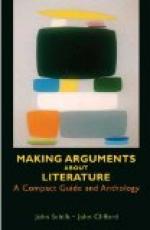In the second place, use your paragraphing for all that it is worth, and that is a great deal. The success of any explanation or argument springs from the way in which it takes a mass of facts apart, and rearranges them simply and perspicuously; and there is no device of composition which helps so much towards clearness as good paragraphing. Accordingly when you come to make your final draft, make certain that each paragraph has unity. If you have any doubts see if you can sum up the paragraph into a single simple sentence. Then look at the beginnings of the paragraphs to see whether you have made it easy for your readers to know what each one is about. Macaulay’s style is on the whole clearer and more effective for a general audience than that of any other writer in English; and his habit of beginning each paragraph with a very definite announcement of its subject is almost a mannerism. Incidentally there is no better rough test of the unity of your paragraphs than thus to give them something of the nature of a title in the first sentence. Often, too, at the end of an important paragraph it is worth while to sum up its essence in pithy form. Mankind in general is lazy about thinking, and more than ready to accept an argument which is easy to remember and repeat. The end of a paragraph is the place for a catchword.
In the third place, bind the sentences in your paragraphs together. When one is building up a first draft, and picking facts from a variety of sources, it is inevitable that the result shall be somewhat disjointed. In working over the first draft, really work it over, and work it together. Make all the sentences point the same way. Pronouns are the most effective connectives that we have; therefore recast your sentences so that there will be as little change of subject as possible. Then use the explicit connectives in as much variety as you can. It is not likely that you will make your paragraphs too closely knit for the average reader.
In the fourth place, bind your argument together as a whole by connectives at the beginnings of the paragraphs and by brief summarizing paragraphs. In the present generation of schoolboys a good many have groaned over Burke’s speech “On Conciliation with America”; but if the first time that one of these sufferers must make an argument in real earnest, he will go back to Burke for some of the devices used to bind that argument together, he will be surprised to see how practically e efficient those devices are. And none of them counts more for clarity and thoroughness than the conscientious way in which Burke took his hearers by the hand at the beginning of each paragraph, and at each turn in his argument, to make sure that they knew just how they were passing from one point to another.
From the doctrine of clear explanation, then, we may carry over to the making of clear arguments the habit of laying out the ground at the beginning, of making the paragraphs do their full work by attending to unity, to emphasis, and to coherence, and of binding the paragraphs together into a closely knit whole.




